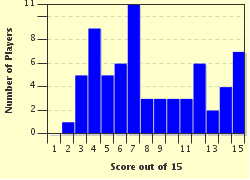Quiz Answer Key and Fun Facts
1. The cult of Saint Michael began in the late 5th century on Monte Gargano, where the archangel had supposedly appeared in a cave. In which present day country is Monte Gargano situated?
2. The granite massif on which the abbey at Mont-Saint-Michel stands is not the only prominent feature in the bay area. There is another small islet situated 3km away that has been described as "Its forlorn rowing boat moored forever in the silvery mirror of the bay". By what name is this small islet known?
3. "Get this into your head, I need my own sanctuary". According to legend, who demanded this in a dream visited upon Bishop Aubert of Avranches in 708?
4. Which great European emperor, who is thought to have visited the mount, imposed the cult and the feast day of Saint Michael on the 29th of September?
5. Alongside its high and tremendously thick battlements, the mount has a greater and far more formidable defence that has claimed the lives of many invaders and pilgrims to the mount alike. Known as 'Tangue' - a word of Viking origin - what is/are these defences?
6. In what architectural style was the original abbey built on the north face - the steepest face - of the rock?
7. The first monks appointed to the abbey were followers of the doctrine of a key figure in history and one who is considered to be one of the forefathers of Europe. Who was this figure?
8. Under the great 12th century abbot Robert de Torigni, what developed on the mount to become one of the greatest of its kind in all of Europe?
9. Fifty metres high and eighty metres long, this addition to the abbey was constructed between 1210 and 1230. Consisting of two blocks of three floors, this building was, and still is, considered to be an emblem of eternal France, 'a skyscraper of its period'. Known as La Merveille (The Marvel) it contains a number of rooms, one being the Salle des Chevaliers. Who would be expected to use this room?
10. In 1421 the abbey's romanesque choir collapsed. At around 1450 the Hundred Years War was coming to an end. With this, pilgrimages to the mount increased again and, consequently, the fortunes of the abbey itself. In 1521-1523, the choir was rebuilt in the gothic style. What is a particular feature of this architectural style?
11. Members of which religious group, tempted by the location and riches of the mount, tried desperately to take over the mount in the final years of the 16th and early years of the 17th centuries?
12. During the year 1790, all monastic orders in France were suppressed due to the French Revolution. By this time and after years of neglect, the abbey on the mount was dirty, dilapidated and, to all intents and purposes, abandoned. At this time the mount underwent, ironically, a change of name to 'Mont-Libre'. For what purpose was the mount used after this date?
13. During the 18th century the abbey on the mount was in possession of its greatest ever number of what exactly?
14. In which year, after campaigns by many of France's romantic artisans including Victor Hugo, Gustave Flaubert and the historian Jules Michelet, was the mount first listed as a historical monument by the French government?
15. The now stunningly beautiful abbey at Mont-Saint-Michel is France's most visited tourist site.
Source: Author
SisterSeagull
This quiz was reviewed by FunTrivia editor
stedman before going online.
Any errors found in FunTrivia content are routinely corrected through our feedback system.


